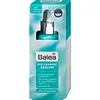What's inside
What's inside
 Key Ingredients
Key Ingredients

 Benefits
Benefits

 Concerns
Concerns

No concerns
 Ingredients Side-by-side
Ingredients Side-by-side

Water
Skin ConditioningCaprylic/Capric Triglyceride
MaskingC13-15 Alkane
SolventGlycerin
HumectantCetearyl Alcohol
EmollientPanthenol
Skin ConditioningSimmondsia Chinensis Seed Oil
EmollientButyrospermum Parkii Butter
Skin ConditioningGlyceryl Stearate
EmollientHydrolyzed Corn Starch
HumectantBeta Vulgaris Root Extract
Skin ConditioningCetearyl Olivate
Pentylene Glycol
Skin ConditioningTocopheryl Acetate
AntioxidantArgania Spinosa Kernel Oil
EmollientDistarch Phosphate
AbsorbentDiglycerin
HumectantDimethicone
EmollientTocopherol 1%
AntioxidantSorbitan Olivate
EmulsifyingMadecassoside
AntioxidantAsiaticoside
AntioxidantCentella Asiatica Leaf Extract
Skin ConditioningCeramide EOP
Skin ConditioningCeramide Ns
Skin ConditioningCeramide NP
Skin ConditioningCeramide As
Skin ConditioningCeramide AP
Skin ConditioningHelianthus Annuus Seed Oil
EmollientTriethyl Citrate
MaskingVanilla Planifolia Fruit Extract
Skin ConditioningSodium Hyaluronate
HumectantAmmonium Acryloyldimethyltaurate/Vp Copolymer
Cholesterol
EmollientHydrogenated Lecithin
EmulsifyingSucrose Distearate
EmollientDipropylene Glycol
HumectantAllantoin
Skin ConditioningHydroxyacetophenone
AntioxidantP-Anisic Acid
MaskingVanillin
MaskingSodium Hydroxide
BufferingLactic Acid
BufferingWater, Caprylic/Capric Triglyceride, C13-15 Alkane, Glycerin, Cetearyl Alcohol, Panthenol, Simmondsia Chinensis Seed Oil, Butyrospermum Parkii Butter, Glyceryl Stearate, Hydrolyzed Corn Starch, Beta Vulgaris Root Extract, Cetearyl Olivate, Pentylene Glycol, Tocopheryl Acetate, Argania Spinosa Kernel Oil, Distarch Phosphate, Diglycerin, Dimethicone, Tocopherol 1%, Sorbitan Olivate, Madecassoside, Asiaticoside, Centella Asiatica Leaf Extract, Ceramide EOP, Ceramide Ns, Ceramide NP, Ceramide As, Ceramide AP, Helianthus Annuus Seed Oil, Triethyl Citrate, Vanilla Planifolia Fruit Extract, Sodium Hyaluronate, Ammonium Acryloyldimethyltaurate/Vp Copolymer, Cholesterol, Hydrogenated Lecithin, Sucrose Distearate, Dipropylene Glycol, Allantoin, Hydroxyacetophenone, P-Anisic Acid, Vanillin, Sodium Hydroxide, Lactic Acid
Water
Skin ConditioningNiacinamide
SmoothingGlycerin
HumectantPentylene Glycol
Skin ConditioningAloe Barbadensis Leaf Juice
Skin ConditioningZinc PCA
HumectantPanthenol
Skin ConditioningPhenoxyethanol
PreservativeCellulose Gum
Emulsion StabilisingAllantoin
Skin ConditioningSodium Benzoate
MaskingCitric Acid
BufferingXanthan Gum
EmulsifyingEthylhexylglycerin
Skin ConditioningTrisodium Ethylenediamine Disuccinate
Sodium Hyaluronate
Humectant
 Reviews
Reviews

Ingredients Explained
These ingredients are found in both products.
Ingredients higher up in an ingredient list are typically present in a larger amount.
Allantoin is a soothing ingredient known for its protective and moisturizingg properties. Because of this, it is often added to products with strong active ingredients.
Studies show higher concentrations of this ingredient can promote wound healing.
Though it can be derived from the comfrey plant, allantoin is produced synthetically for cosmetic products to ensure purity.
Learn more about AllantoinGlycerin is already naturally found in your skin. It helps moisturize and protect your skin.
A study from 2016 found glycerin to be more effective as a humectant than AHAs and hyaluronic acid.
As a humectant, it helps the skin stay hydrated by pulling moisture to your skin. The low molecular weight of glycerin allows it to pull moisture into the deeper layers of your skin.
Hydrated skin improves your skin barrier; Your skin barrier helps protect against irritants and bacteria.
Glycerin has also been found to have antimicrobial and antiviral properties. Due to these properties, glycerin is often used in wound and burn treatments.
In cosmetics, glycerin is usually derived from plants such as soybean or palm. However, it can also be sourced from animals, such as tallow or animal fat.
This ingredient is organic, colorless, odorless, and non-toxic.
Glycerin is the name for this ingredient in American English. British English uses Glycerol/Glycerine.
Learn more about GlycerinPanthenol is a common ingredient that helps hydrate and soothe the skin. It is found naturally in our skin and hair.
There are two forms of panthenol: D and L.
D-panthenol is also known as dexpanthenol. Most cosmetics use dexpanthenol or a mixture of D and L-panthenol.
Panthenol is famous due to its ability to go deeper into the skin's layers. Using this ingredient has numerous pros (and no cons):
Like hyaluronic acid, panthenol is a humectant. Humectants are able to bind and hold large amounts of water to keep skin hydrated.
This ingredient works well for wound healing. It works by increasing tissue in the wound and helps close open wounds.
Once oxidized, panthenol converts to pantothenic acid. Panthothenic acid is found in all living cells.
This ingredient is also referred to as pro-vitamin B5.
Learn more about PanthenolPentylene glycol is typically used within a product to thicken it. It also adds a smooth, soft, and moisturizing feel to the product. It is naturally found in plants such as sugar beets.
The hydrophilic trait of Pentylene Glycol makes it a humectant. As a humectant, Pentylene Glycol helps draw moisture from the air to your skin. This can help keep your skin hydrated.
This property also makes Pentylene Glycol a great texture enhancer. It can also help thicken or stabilize a product.
Pentylene Glycol also acts as a mild preservative and helps to keep a product microbe-free.
Some people may experience mild eye and skin irritation from Pentylene Glycol. We always recommend speaking with a professional about using this ingredient in your routine.
Pentylene Glycol has a low molecular weight and is part of the 1,2-glycol family.
Learn more about Pentylene GlycolSodium Hyaluronate is hyaluronic acid's salt form. It is commonly derived from the sodium salt of hyaluronic acid.
Like hyaluronic acid, it is great at holding water and acts as a humectant. This makes it a great skin hydrating ingredient.
Sodium Hyaluronate is naturally occurring in our bodies and is mostly found in eye fluid and joints.
These are some other common types of Hyaluronic Acid:
Learn more about Sodium HyaluronateWater. It's the most common cosmetic ingredient of all. You'll usually see it at the top of ingredient lists, meaning that it makes up the largest part of the product.
So why is it so popular? Water most often acts as a solvent - this means that it helps dissolve other ingredients into the formulation.
You'll also recognize water as that liquid we all need to stay alive. If you see this, drink a glass of water. Stay hydrated!
Learn more about Water